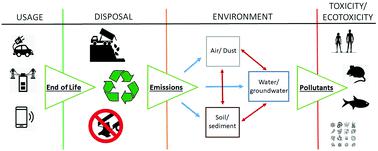当前位置:
X-MOL 学术
›
Energy Environ. Sci.
›
论文详情
Our official English website, www.x-mol.net, welcomes your
feedback! (Note: you will need to create a separate account there.)
Environmental impacts, pollution sources and pathways of spent lithium-ion batteries
Energy & Environmental Science ( IF 32.4 ) Pub Date : 2021-10-13 , DOI: 10.1039/d1ee00691f Wojciech Mrozik 1, 2, 3 , Mohammad Ali Rajaeifar 1, 2 , Oliver Heidrich 1, 2 , Paul Christensen 1, 2, 3
Energy & Environmental Science ( IF 32.4 ) Pub Date : 2021-10-13 , DOI: 10.1039/d1ee00691f Wojciech Mrozik 1, 2, 3 , Mohammad Ali Rajaeifar 1, 2 , Oliver Heidrich 1, 2 , Paul Christensen 1, 2, 3
Affiliation

|
There is a growing demand for lithium-ion batteries (LIBs) for electric transportation and to support the application of renewable energies by auxiliary energy storage systems. This surge in demand requires a concomitant increase in production and, down the line, leads to large numbers of spent LIBs. The ever-increasing battery waste needs to be managed accordingly. Currently, there are no universal or unified standards for waste disposal of LIBs around the globe. Each country uses one or a combination of practices such as landfilling, incineration and full or partial recycling depending on the number of batteries leaving the market, current legislation and infrastructures. Informal disposal or reprocessing is not a rare activity. This review records, identifies and categorises the environmental impacts, sources and pollution pathways of spent LIBs. The drawbacks of the disposal practices are highlighted and the threats associated with them are discussed. The evidence presented here is taken from real-life incidents and it shows that improper or careless processing and disposal of spent batteries leads to contamination of the soil, water and air. The toxicity of the battery material is a direct threat to organisms on various trophic levels as well as direct threats to human health. Identified pollution pathways are via leaching, disintegration and degradation of the batteries, however violent incidents such as fires and explosions are also significant. Finally, the paper discusses some of the main knowledge gaps for future assessments. The current study offers a comprehensive overview of the threats and hazards that need to be managed in order to ensure the design and implementation of safe disposal and processing options for spent LIBs.
中文翻译:

废锂离子电池的环境影响、污染源及途径
电动交通对锂离子电池 (LIB) 的需求不断增长,并通过辅助储能系统支持可再生能源的应用。需求的激增需要随之而来的产量增加,并最终导致大量废锂离子电池。需要相应地管理不断增加的电池浪费。目前,全球对锂离子电池的废物处置没有统一或统一的标准。每个国家根据离开市场的电池数量、现行立法和基础设施,使用一种或多种做法,例如填埋、焚烧和全部或部分回收。非正式处置或再处理并不是一种罕见的活动。该审查记录、识别和分类环境影响,废锂离子电池的来源和污染途径。强调了处置做法的缺点,并讨论了与之相关的威胁。这里提供的证据取自现实生活中的事件,它表明对废电池的不当或粗心处理和处置会导致土壤、水和空气受到污染。电池材料的毒性是对各种营养级生物的直接威胁,也是对人类健康的直接威胁。已确定的污染途径是 电池材料的毒性是对各种营养级生物的直接威胁,也是对人类健康的直接威胁。已确定的污染途径是 电池材料的毒性是对各种营养级生物的直接威胁,也是对人类健康的直接威胁。已确定的污染途径是通过电池的浸出、分解和降解,但火灾和爆炸等暴力事件也很严重。最后,本文讨论了未来评估的一些主要知识差距。当前的研究全面概述了需要管理的威胁和危害,以确保设计和实施废 LIB 的安全处置和处理选项。
更新日期:2021-10-27
中文翻译:

废锂离子电池的环境影响、污染源及途径
电动交通对锂离子电池 (LIB) 的需求不断增长,并通过辅助储能系统支持可再生能源的应用。需求的激增需要随之而来的产量增加,并最终导致大量废锂离子电池。需要相应地管理不断增加的电池浪费。目前,全球对锂离子电池的废物处置没有统一或统一的标准。每个国家根据离开市场的电池数量、现行立法和基础设施,使用一种或多种做法,例如填埋、焚烧和全部或部分回收。非正式处置或再处理并不是一种罕见的活动。该审查记录、识别和分类环境影响,废锂离子电池的来源和污染途径。强调了处置做法的缺点,并讨论了与之相关的威胁。这里提供的证据取自现实生活中的事件,它表明对废电池的不当或粗心处理和处置会导致土壤、水和空气受到污染。电池材料的毒性是对各种营养级生物的直接威胁,也是对人类健康的直接威胁。已确定的污染途径是 电池材料的毒性是对各种营养级生物的直接威胁,也是对人类健康的直接威胁。已确定的污染途径是 电池材料的毒性是对各种营养级生物的直接威胁,也是对人类健康的直接威胁。已确定的污染途径是通过电池的浸出、分解和降解,但火灾和爆炸等暴力事件也很严重。最后,本文讨论了未来评估的一些主要知识差距。当前的研究全面概述了需要管理的威胁和危害,以确保设计和实施废 LIB 的安全处置和处理选项。









































 京公网安备 11010802027423号
京公网安备 11010802027423号